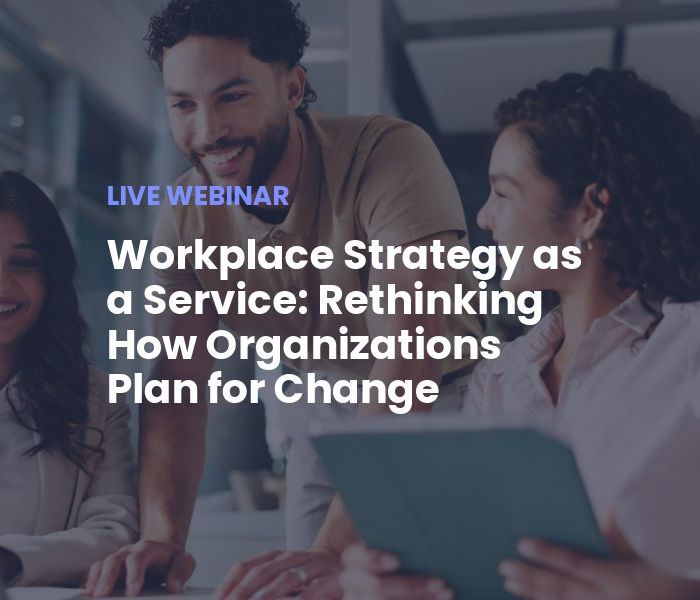The 3 Pillars of Workplace Transformation
As the pandemic comes under control and businesses begin to move toward greater normalcy, many have chosen to pursue lasting workplace transformation initiatives. Businesses are transitioning to a hybrid workplace model, actively redesigning physical spaces, adopting more digital processes and tools, and re-evaluating existing real estate portfolios.
What does workplace transformation involve? It is digital transformation that encompasses three key workplace pillars:

- Exceptional workplaces are uniquely designed and tailored for your company’s populations of employees. These physical buildings are safe and healthy places for employees to work, with a heightened focus on environmental factors such as indoor air quality.
- Right-fit real estate portfolios have the right mix of spaces and locations to support the needs of your workforce. Right-fit real estate can build a high-performing portfolio that exceeds goals for utilization, energy efficiency, sustainability, and cost effectiveness.
- Finally, to achieve transformation, your company will need to provide employees with ideal workplace experiences. Employees crave the flexibility to craft their ideal workday in terms of schedule/time and place. Each employee, working with their teams, can have the autonomy to maximize their productivity while balancing their personal obligations.
Working with FM:Systems clients, we’ve identified four key areas where we see businesses encountering obstacles and challenges on the journey to workplace transformation. Let’s explore each challenge area in more detail.

Enabling Employee Productivity
There are many benefits to a hybrid workplace where employees spend some days working from home and other days in the office. The past year demonstrated that many employees can achieve higher productivity at home, for several reasons. A recent Mercer survey of more than 800 employees found 94% said productivity stayed the same or increased during the shift to virtual work.[i]
With some research and planning, employers can provide tools, policies, and processes that support high productivity for remote workers going forward. Here are four things that Facilities Management need to think about:
- Collaborative spaces: Most companies with a hybrid workplace see employees coming to the office for meetings and collaboration time with their teams. They need to design more spaces conducive to group collaboration and innovation.
- Visibility into schedules and resources: Employees can’t choose the best days to come into the office for collaboration without being able to see their coworkers schedules and plans. Additionally, they need to be able to verify that a desk or conference room will be available for them. Then, they need to be able to reserve those spaces. Scheduling and reservations systems need to be very easy to use and convenient, because you really want all employees to adopt these habits. Offering multiple interfaces and workflows can drive higher adoption. For example, some employees prefer to schedule and calendar in Outlook while others prefer to use mobile apps.
- Collaboration with IT: IT and facilities must work more closely than ever before, because the key element of a hybrid workplace experience is exceptional digital infrastructure. Learn about applications currently in use and others that could improve employee experience. IT can help you plan how to layer new facilities technology into the existing tech stack.
- Collaboration with HR: The Facilities team needs HR to listen to employee feedback about the hybrid workplace and offer suggestions for improvement. Workplace transformation is a process, and HR will need to check in with employees often along this journey. Routine surveys can help you measure and understand employee preferences and sentiment. Be sure to include some open-ended questions for free form answers. You might get some great ideas.

Increased Protocols and Decreased Predictability
Pandemic response introduced new important employee health and safety considerations, such as social distancing, hand washing, and so on. These considerations resulted in new policies for sanitization, space management, and health and wellness.
These issues are much more complex than they may initially seem. For example, how will you maintain social distancing, while at the same time, allowing employees to float between the office and remote work? You will need a system for not only taking reservations, but also either assigning workspaces (so you can leave some seats empty) or redesigning your floor plans such that all workspaces are properly distanced. How will you handle visitor check-ins? And how will you track all of this data, so you can ensure health and safety in the event that someone in the building becomes ill?
Learn how Southwest Airlines used FMS:Workplace data to inform key strategic decisions about sanitization and scheduling.
Sanitization is another key area. Businesses have to plan cleaning schedules and map out sanitization policies. When it comes to collaborative spaces, how will you ensure sanitization? Will you ask employees to clean a conference room after using it? Will you automatically schedule janitorial services or facilities to clean it based on reservation times? Proper sanitization is critical to maintaining a safe workplace, but it is equally important to have high transparency. In other words, employees need to have a way to know and verify a space has been cleaned.

Multi-Million Dollar Real Estate Decisions
If businesses adopt a hybrid workplace, will they have too much real estate as a result? That question is on the minds of most Facilities Management professionals. Now is the time to begin examining your space utilization with an eye to future changes. Small changes to right size and optimize your real estate portfolio can make a big difference.
The average lease and operating cost for a single workstation is $10,000 per year. How many fewer might your business need with a hybrid workforce? Some FM:Systems clients are adjusting their employees-to-desks ratio. Before the pandemic, a 1.5:1 ratio felt a little edgy. Today, some clients are using a 2.5:1 ratio.
Pre-pandemic, the average workspace density was 125 square feet per workstation. In 2020, social distancing expanded that number to 200-250 square feet per workstation. However, in the years to come, we might see greater workspace density again.
Want to calculate potential cost savings associated with making small changes to your workspaces? Download our free workplace cost-savings calculator >
When you’re ready to optimize your real estate portfolio, make sure you’ve identified the right spaces to eliminate or redesign. Surveys, utilization data, and environmental sensors can all be used to determine spaces that get used and those that don’t. Understanding why can help you ensure you retain the best spaces for your employee while giving up those of least benefit.

IT Protocols and Security
Hybrid workplace transformation requires a big shift toward cloud and mobile applications. That means your company will need to revisit issues like cybersecurity and device management in light of the hybrid workforce. For example, will you allow employees to use personal devices at work (BYOD) or will the company provide mobile devices? Will employees download mobile workplace apps directly? Do you have security concerns that merit using a Mobile Device Management (MDM) provider for secure delivery of mobile apps?
With employees leaving the office to work remotely, the cybersecurity threat surface expands. A recent Mimecast survey revealed 79% of respondent companies experienced business disruption or financial loss in 2020 due to a lack of cyber preparedness.[ii] It is critical that the Facilities team work closely with IT on this issue. Additionally, businesses need an IT asset management system and policies as employees leave the office with company computers, laptops, monitors and devices.

Overcome obstacles with adaptability
As you address the four challenge areas listed above, you will experience some setbacks. We are all still learning about what the hybrid workplace will mean and how it will function most effectively. Adaptability is your greatest tool. So, don’t think of ideas or strategies that don’t work as failures; instead, view them as learning opportunities. Listen to employees. Learn from each other. Adjust your plan and adapt.
Watch our webcast on-demand where we dive even deeper into the obstacles organizations are facing across the globe as we recognize the benefits and adopt flexible work as a long-term strategy.
[i] SHRM, “Study finds productivity not deterred by shift to remote work,” September 16, 2020.
[ii] Help Net Security, “61% of organizations impacted by ransomware in 2020,” April 26, 2021.










